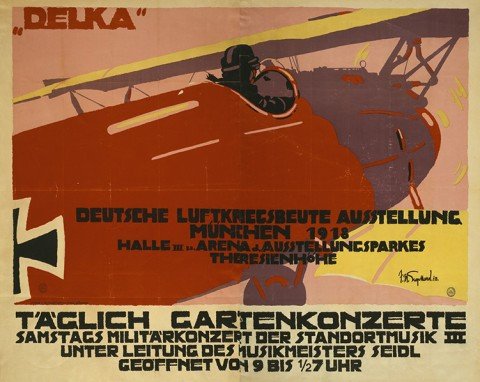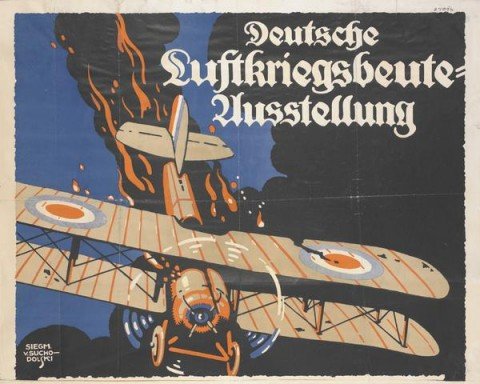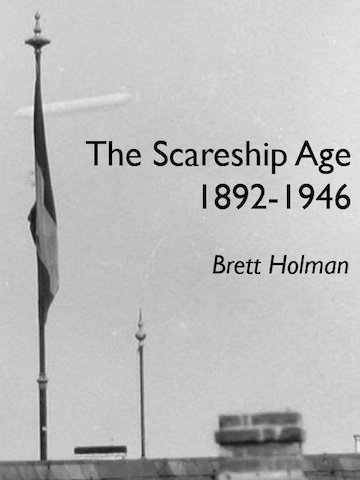While searching for images to illustrate my Wartime article, I came across this German propaganda poster from 1918. It ultimately didn’t make the cut but I think it’s very interesting. The seaplane soaring into the top left of the poster is a Friedrichshafen FF.33; in fact it is the very one which scouted for the raider Wolf during its voyage into Australasian waters in 1917, Wölfchen (‘Little wolf’ or rather ‘Wolf’s cub’). But what about the two people in the lower right, cowering in fear before the swooping aeroplane? They appear to be stereotypical and somewhat racist images of Africans, or possibly Papuans. I suspect the latter. The Wolf came close to Africa twice, near the Cape of Good Hope on both its outbound and inbound legs, but it also sailed past Rabaul after preying on Allied shipping in the South Pacific. Rabaul would have had more resonance for Germans than South Africa, because it had been the capital of German New Guinea until 1914, when the Australians occupied the colony. So perhaps this poster should be seen as suggesting to the German public that Wolf‘s visit was a token of Germany’s continuing claims in New Guinea and would soon return to reclaim its imperial possessions. And that it had reminded the natives who their real masters were.
But the poster had a more overt purpose, indicated by the text at the bottom: to advertise the Deutsche Luftkriegsbeute Ausstellung, or ‘German air war booty exhibition’, held in Munich sometime in 1918 (after February, when Wolf returned to Germany, and before November, presumably) along with associated military concerts. Presumably these were primarily propaganda exercises to rally the home front, but they may also have been used to raise funds for the war effort. However, I haven’t been able to find much information about the exhibition, other than this poster and the rather striking ones below. (Apparently a pocket guide is still extant.)

This one, which appears to be a generic poster with a blank space for organisers to fill in with more timely information about the exhibition, also shows the Wölfchen, this time in profile view, and presumably that’s Wolf itself steaming into the lefthand side. Presumably the aircraft itself was on display in the exhibition. The fact that Wölfchen was used twice must tell us something of the propaganda impact of Wolf‘s successes in successfully evading all the Allied navies after sinking so many merchant ships; no other recognisable individual aircraft appears in the posters I’ve found, not even the Red Baron’s Dreidecker. But equally it might tell us something of the desperation beginning to be felt in Germany in 1918, because after all Wolf‘s successes could not and did not alter the course of the war.
Here’s another exhibition poster showing a German aeroplane. Or rather the left half of one…
… here’s the right half…
… and here they are stitched together somewhat ineptly by myself. (Click for full size.) It shows an Albatros D.V, engine running and presumably in flight. The word ‘DELKA’ in the top left corner might be thought to be the name of the Albatros, or maybe the pilot, contrary to my claim above that there are no specific aeroplanes identified in these posters. But it reappears in the last poster reproduced below and I think DELKA is just an acronym for the exhibition itself, i.e. DEutsche LuftKriegsbeute Ausstellung.
Most of the posters are more like this, showing German airpower dominating Allied airpower, usually signified by an imperial eagle and a terminally damaged enemy aeroplane. And that’s what you’d expect from a war trophy exhibition, captured machines, not friendly ones like the Wölfchen and the Albatros. But that’s being pedantic, and maybe there’s some nuance to the word Kriegsbeute which I’m not picking up.
It’s noticeable that all the Allied machines in these posters are actually British machines. Why no French ones? The French Aéronautique Militaire was as big as the RAF or bigger, certainly not to be sneered at; yet all the roundels are blue on the outside and red on the inside. Were the British seen as the main opponents in the air? Or is it just that these are the only DELKA posters which are to be found in museum collections in the English-speaking world because they were more interesting to English-speaking collectors?
Also, the aircraft depicted appear to all be fighters, not bombers or scouts (apart from the Wölfchen), of course). So they seem to be playing into the ‘knights of the air’ myth, as popular in Germany as it was elsewhere, and not, for example, making claims about how well-protected German cities are against air raids. (Which only affected a very small proportion of Germans, of course, and mostly in the west: Munich apparently received just three bombs over the whole war.)
The grisly sight of Allied planes twisting, burning to the ground showed the German public that the Reich would stop at nothing to win.
— Peter Fritszche, A Nation of Fliers: German Aviation and the Popular Imagination (Cambridge and London: Harvard University Press, 1992), 94.
The last poster (and possibly the preceding one) is actually not from the 1918 DELKA, but the 1917 one, so it seems to have been a semi-regular event (though possibly only held twice). And possibly a travelling one too — there’s no specific location given (other than the ‘Zoo’), but this poster was printed in Berlin, whereas some or all of the ones above were printed in Munich, so maybe that’s where it was held. That’s the only evidence I’ve found for the 1917 DELKA, though, apart from a modified version of the same poster showing it was still on in March as well as February.
Sources: Visual Arts Data Service, here, here, here, here and here; Library of Congress, here and here. The VADS links also include transcriptions and translations of the text.
![]() This work is licensed under a Creative Commons Attribution-NonCommercial-NoDerivatives 4.0 International License.
Permissions beyond the scope of this license may be available at http://airminded.org/copyright/.
This work is licensed under a Creative Commons Attribution-NonCommercial-NoDerivatives 4.0 International License.
Permissions beyond the scope of this license may be available at http://airminded.org/copyright/.












The Germans considered the UK to be the Hauptfeind, especially by 1917.
Very interesting! Just a couple of notes.
The artists seem to have been confused by multi-bay and single-bay biplanes, and insist on putting a set of struts next to the fuselage, where struts should generally not be. Like the philately principle, most of the Allied aircraft have been made somewhat generic, but the second last aircraft looks most like a Nieuport 28 (round wingtips, rotary engine in bowl cowling) and the third last image’s aircraft looks like a SPAD, with the characteristic SPAD nose and radiator. French designs. Offhand, I can’t think of any British designs that fit as well.
The aircraft ‘breaking up’ after Imperial Eagle attack could be a Sopwith, by the tail and wingtip shape, or – just – a Nieuport 17 or even a Hanriot HD.1. Notably most of those were, indeed used by the RFC or RNAS as well as other nations and France, although the Nieuport 28 did not see British service.
Before he was (in)famous in an all-red Fokker Dr.I, Manfried was well known for his red Albatros, of course…
We can’t be sure of the artist’s intent, but I’ve seen an Albatros [replica] from exactly that position while it was being run up on the ground.
Like the eagle. My 1970s New English Library edition of The Riddle of the Sands has a very similar eagle as part of the cover design. Was this a standard version of the German Imperial Eagle?
Another interesting aspect is the remarkable depth of understanding of the technology they’re illustrating (or perhaps a more modern aesthetic) compared to only a few years earlier when artists cheerfully had people doing things aboard aircraft (such as tossing bouquets ahead of them) that were physically impossible. However at least one artist isn’t aware of how flappy an aileron would be with an eagle on its trailing edge. Obviously symbolic eagles have no mass.
Alex:
Yes, there was the whole Gott strafe England thing. Matthew Stibbe’s German Anglophobia and the Great War, 1914–1918 is the go-to book on this topic (which I haven’t gone to). I’m just surprised at the exclusive focus — surely the French were worthy of a little hate, too. Probably not possible to draw meaningful conclusions from such a small sample, anyway.
James:
But not with yellow wings though? It’s quite possible that some Albatros pilot did but a very quick search doesn’t show up any famous examples.
True. But that’s not as heroic!
This cover? It does look very similar to the last eagle (other than being reversed), perhaps even identical? Though that picture is too small to tell. Again, Google doesn’t immediately throw up any other examples. But those two posters are by different artists, so maybe it was indeed recognised iconography.
Yes, that cover. It’s too similar to be purely coincidental, and the main difference is it’s more angular than curved like the ones above around the beak and head, but I reckon it’s based on the same design.
Apparently his Albatros D.IIIs were part-red (red fuselage and tail) and camouflaged or lozenge-fabric wings, while his D.V and some Fokker Dr.Is were the all-red examples.
We can get into whether or not the artist chose yellow wings because of the limited colour palette, or the design for contrast, but in 1918, a (partly) red Jäger on a German poster? I wonder if it’s generic or alluding to someone… Go on, you guess.
Maybe. As we’re talking iconography and propaganda, it would depend on how informed the German public was about the exact colour schemes he used. His nickname was der rote Kampfflieger, ‘the red battle flyer’, would people see a part-red Albatros and think of him or would they expect an all-red aeroplane? I haven’t been to find anything in English-language sources to say one way or the other. (Interesting: according to Fritzsche, while Richthofen was certainly lionised in the press, film, books, etc, the German public never warmed to him as they had with Boelcke. Doesn’t really bear on this question though.)
There’s also the question of chronology. Unfortunately there’s not much in the DELKA posters to narrow the dates down, other than Wölfchen itself, which returned to Germany on 24 February. Richthofen was killed on 21 April, so the poster would need to have been designed by then, if it is him. Given that Wölfchen probably only had news value for a month or two that’s not a bad fit. On the other hand, Richthofen was now flying DR.Is (and I did not realise he only flew these in combat for the last 5 or so weeks of his life!), not the D.Vs he would have been associated with in 1917. So we’re back to the problem of what the German public ‘knew’ about him at this time — were there lots of news stories about his new all-red triplane or was the older image still dominant?
I think there’s a danger to over think it. It’s a red ‘plane on a poster. Given that someone chose that colour, the probability is there’s a reference – however distant – being made.
Conversely, we don’t have a portrait of MvR in the cockpit, and his face was familiar enough that could’ve been done.
Whatever. Neat posters, I’ll get versions for my German design scheme library, just down from the interwar airliner schemed library!
Oh, no doubt. But, ironically, this is basically what I’m saying: if Germans at the time had to over think it in order to work out the poster was referring to Richthofen, then it wasn’t effective propaganda.
But either way, a distant reference? I can live with that!